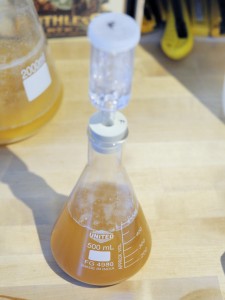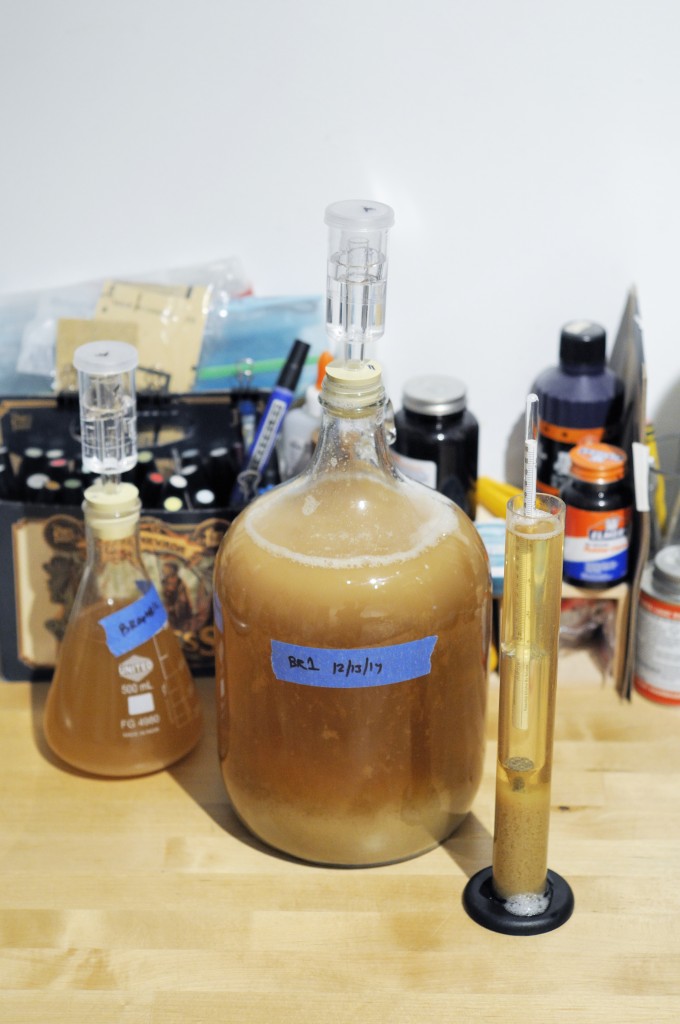
I have typically been keeping my house sour culture refreshed with frequent feedings of starter wort.
Over the past couple of years, I’ve cultured and grown up bottle dregs from a variety of commercial sour beers to complete several different projects. These dregs are a great way to add biodiversity to the commercial blends (like Roeselare) that I typically start a sour beer with and tend to produce a more interesting final product. As I acquired these cultures, I began combining them with the intent of developing a variety of house-mixed cultures of bacteria and yeast that I can maintain and use to completely ferment out sour beers. The intent is to continue shaping these mixed cultures until they get to the point where they can consistently produce quality sour beer in a predictable time frame. I fully expect the blend of microbes within the culture to drift, but hope an eventual homeostasis will take hold within the culture. Currently, I have built three different mixed cultures around a spectrum of cultured microbes harvested from commercial beers.
One of the biggest tasks in maintaining a culture like this is the frequent feedings required to keep a culture viable. The idea of maintaining my cultures through periodic feedings of fresh wort that would eventually provide the steady byproduct of sour beer seemed like a great idea. And so, the idea of a sour culture bio-reactor was born. The idea is pretty basic. I’ve put together a schedule of brew days that in theory will consistently provide nutrition for the culture as well as produce a steady stream of sour beer for evaluation. Every four months I brew a different 3-gallon batch of moderate gravity wort that gets split three ways to feed one gallon of fresh wort to each of my three mixed cultures. On brew day I transfer the previous batches of now fermented beer off the culture to a clean glass aging vessel where it will continue to develop for another 8 months (1-year total fermentation time) before packaging. The cultures are then transferred to the freshly brewed wort for a new round of fermentation. After the initial one-year cycle, the bioreactor will consistently output three, 1-gallon batches of sour beer every four months. The beauty of running three cultures in parallel with the same wort is that I’ll be able to compare side-by-side the impact each different culture has on the finished product. My hope is to experiment with different grain bills to better understand the interrelationship between grain bills, mash temperatures, and mixed culture fermentation.
I initially started this project using a single mixed culture. To date, this culture has been through 3 generations of wort. I’ve tasted the first two generations (currently 4-months and 8-months old) and the results have been pretty outstanding; and consistent within the limited sample thus far. I’m optimistic that with some luck and diligence I’ll be able to shape these cultures to the point that they produce sour beer that is both delicious and unique to my brewery.
The first round in the bioreactor ready for fermentation. The initial recipe was 90% Pilsner, 10% Carapils, and had a starting gravity of 1.054.



Hi there,
Have you posted an update? Are you happy with your cultures using this method?
Cheers
Thanks for the question! The very first is in bottles and scheduled to be tasted. So far the results are promising, and have expanded the program to about 4 other mixed blends. Hopefully out of the group, I’ll end up with a couple interesting performers!
Sweet, thanks for the update!